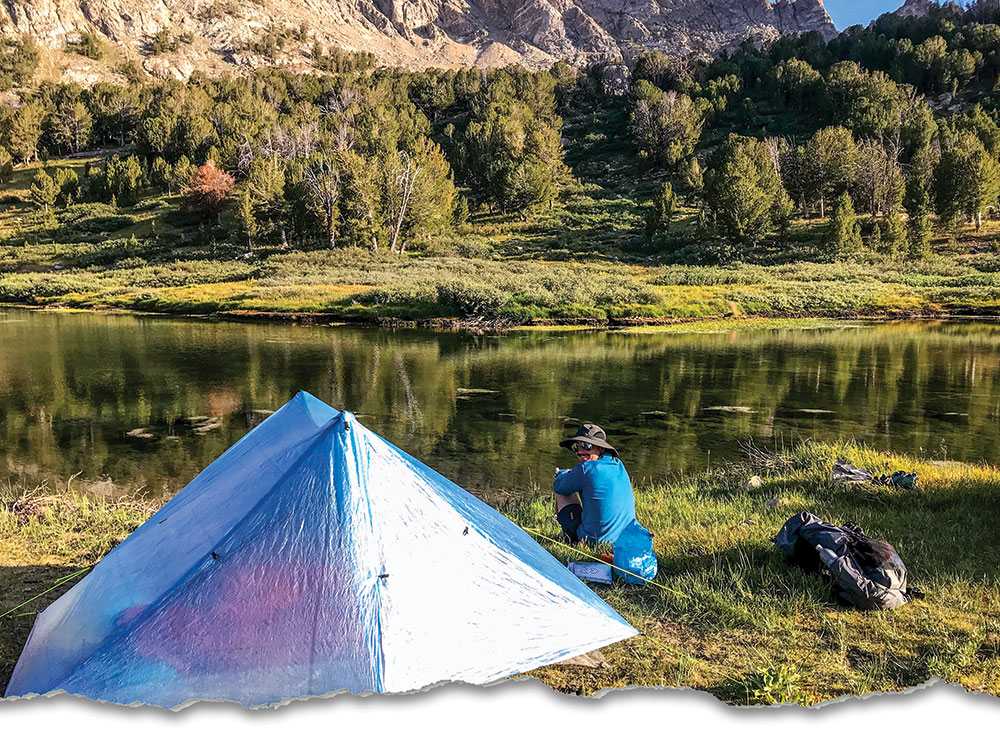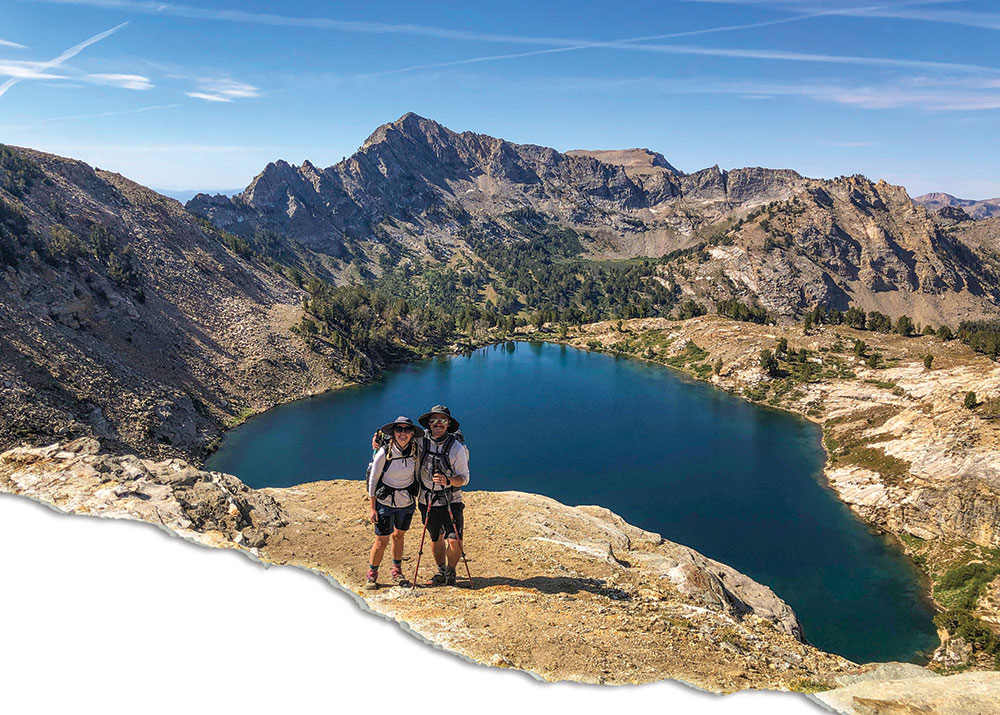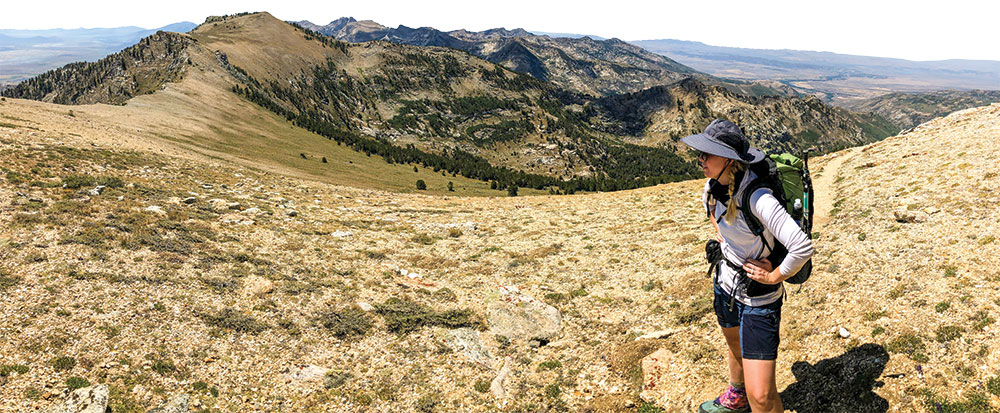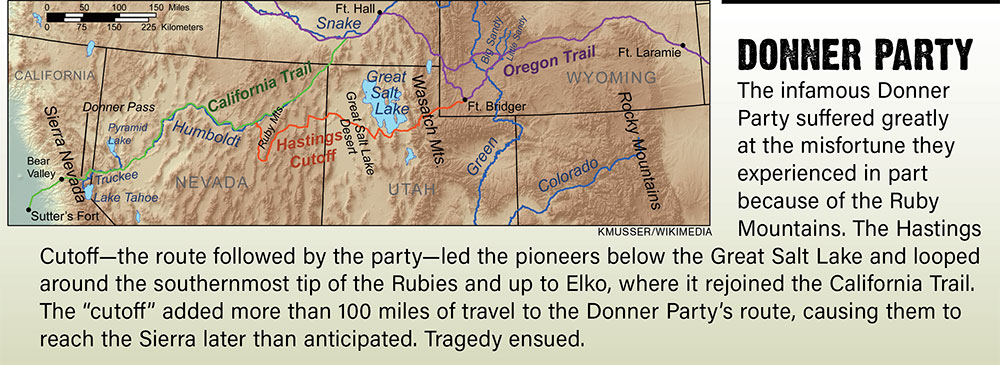Ruby Crest Trail
Fall 2021
Hiking eastern Nevada’s gem offers a precious view of a pristine place.
 STORY AND PHOTOS BY ERIC CACHINERO
STORY AND PHOTOS BY ERIC CACHINERO
Gems typically aren’t discovered in abundance. Their beauty and the emotions they conjure aren’t forged from commonality: their rarity makes them special. So, too, many natural “gems” of Nevada are just that—beautiful due to their rarity, radiant in color and spirit. The Ruby Mountains—one of Nevada’s most precious gems—evoke a sense of discovering some elegant treasure. It’s like walking though a field of sagebrush and stumbling upon a shimmer of color peeking up from the dull dirt—a glimpse of something that begs to be studied. Just as someone might study a gem’s unique characteristics, the Ruby Mountains provide countless opportunities to get a closer look and a deeper understanding.
FOOLS’ RUBIES
The name Ruby Mountains is somewhat of a misplaced moniker. Prospectors in the mid-1800s searching for gold and silver instead found an abundance of red stones. Unfortunately, the seemingly rare and valuable stones were nothing more than the common garnet. Despite history’s best attempts at naming it the Garnet Range, Ruby Mountains stuck—and probably for good reason. Though the garnet’s beauty is apparent, the Ruby Mountains—or the Rubies, as locals refer to them—provide a level of attraction elevated far beyond a semi-precious stone.
As with many places in the Silver State, they are best viewed close up—hiking in this case. In August 2020, my wife Jillian and I decided to view the beauty of the Rubies for ourselves via the Ruby Crest Trail, a 43- (35 by some accounts) mile-trail that entwines hikers in some of the state’s most pristine and soul-enriching landscapes.
DAY 1
Summer haze greets soft-lit peaks as we gaze across the day’s objective. Our boots find first dirt at Harrison Pass—located roughly 50 miles southeast of Elko. Waves of excitement (or is it uncertainty?) wash over me as we take our first steps on the trail. Our starting point at the southern end of the Rubies, while scenic, is standard desert hiking. By starting at the southern end and working north, the beauty of the Rubies increases with each day, culminating in Lamoille Canyon.
We’re traversing sagebrush and rocks as the trail winds its way up an old Jeep road. The technical start of the trail is up ahead at the southern boundary of the Ruby Mountains Wilderness Area, though we decide to hike in a couple extra miles rather than drive. At the base of the wilderness area, the road turns to singletrack trail, and the feelings of immersion intensify.
 A couple miles into the hike, we’re greeted with our first crossroads. One fork erupts straight up the steepest, rockiest monstrosity I’ve ever laid eyes upon. The other winds downhill lazily, though in the complete opposite direction of where we think the trail should go. Against my better judgement—and against Jillian’s futile protest—I suggest we take the high road, or in this case, the treacherous precipice that ascends thousands of feet of loose shale and granite boulders.
A couple miles into the hike, we’re greeted with our first crossroads. One fork erupts straight up the steepest, rockiest monstrosity I’ve ever laid eyes upon. The other winds downhill lazily, though in the complete opposite direction of where we think the trail should go. Against my better judgement—and against Jillian’s futile protest—I suggest we take the high road, or in this case, the treacherous precipice that ascends thousands of feet of loose shale and granite boulders.
 A quick aside, the Ruby Mountains are the only location in Nevada where the Himalayan Snowcock—a large, grey, pheasant-like bird—lives. The feathered creature hails from the Himalayas in Asia, which are, of course, home to the world’s tallest peak—Mt. Everest—at more than 29,000 feet.
A quick aside, the Ruby Mountains are the only location in Nevada where the Himalayan Snowcock—a large, grey, pheasant-like bird—lives. The feathered creature hails from the Himalayas in Asia, which are, of course, home to the world’s tallest peak—Mt. Everest—at more than 29,000 feet.
Back to the climb. As we’re trudging breathless up a hill into Himalayan Snowcock territory, I start to wonder if maybe, just maybe, we’re perhaps on the wrong trail. Luckily, the views at the top are nice, though my wife’s “I told you so’s” pierce the natural silence of the place.
As I trudge back down the trail behind the trip’s new self-appointed master navigator, the correct trail comes into view, and we’re back in business. We’re ready for lunch just as we come upon the first potential water source, which is completely dry.
Snacking takes place in the shade, and soon we’re back on course. We begin to see the first shimmers of the terrain that awaits us. Each turn reveals more beauty than the last, and soon we find ourselves with childlike giddiness as we approach each ridgeline, eager to peek and discover what lies in the next valley. This continues for most of the day, and about an hour before night falls we arrive at our first campsite of the trip: the south fork of Smith Creek. We have the place all to ourselves, save a couple cows that lull us to sleep with their mellifluous mooing.

DAY 2
The sun’s first rays coax us out of our tent, as does the acceptance of our imminent aloneness. It’s a strange feeling being truly alone, with little connection to the outside world. For most of us, even if we’re lonely and cooped up at home, all we need to do is walk outside or drive around for five minutes before we see another human. This is not the case here. Nature takes a firmer grip. We wander deep into the high-desert void.
The sights, sounds, and smells are pleasant. Though it’s August, overripe wildflowers still solicit their seductive colors, and chipmunks and songbirds make chaotic getaways as we round each corner. Our winding path along the eastern flank of the Rubies leads us through the middle and north forks of Smith Creek, allowing for occasional gluttonous chugs of the coldest and freshest rock-filtered spring water in the region. We step lightly and laugh as we walk before coming face-to-face with the trail’s first major climb (not counting the aforementioned scenic detour).
The switchback stares back at us as we prepare for the hike ahead. Our calves and thighs are set ablaze during the ascent. We finally reach the top and peek down the other side into the majestic Ruby Valley, though something is amiss.
Is that…snow? …popcorn?
Unfortunately for us, the hills are not covered in either: they’re dotted with hundreds of domestic lambs and sheep. We take lunchtime refuge just off the trail at the top of the peak and watch a series of sheepdogs working their magic to keep the stubborn balls of wool from wandering off.
As we reach the top of the trip’s first major climb, we find ourselves face-to-face with another nonnative animal. I had expected to see mule deer and had hoped to catch a glimpse of a mountain goat, however, toward the peak, Jillian and I encounter animals that—ironically—also prefer to live in one of the Earth’s tallest mountain ranges. Two alpacas—native to the Andes Range in South America—graze cautiously as we trespass their hangout.
When we reach the top of the crest, we’re greeted with the most spectacular view of the trail yet: the emerald shimmer of Overland Lake, our destination for the day. The rocky and steep descent to the lake keeps our eyes planted mostly at the trail, though we take the occasional peek at the gleaming alpine oasis.
The remainder of the day is spent swimming in the cool mountain waters and reeling in the occasional brook trout. We pitch our tent by the lake, eat a quick dinner, and call it a night before the sun does, because tomorrow is the longest, driest, and steepest section of the trail.
DAY 3
The dull amber glow of a camp stove lights the air as we cram our gear into our packs. Some swear that gourmet French press coffee provides a superior taste and experience; however, I’m inclined on this morning to argue it holds no candle to watery instant coffee hastily prepared and drunk with Mother Nature’s company.
Our pre-dawn departure leaves us stumbling and searching for the correct trail, but it’s not long before we find ourselves walking and waking with the world. A mile or two from Overland Lake, we’re greeted by an impressive (by Nevada standards) waterfall, which provides the last reliable chance at water until we reach our destination for the day—Favre Lake. Ahead of us lies nearly 10 miles of dry trail that traverses five summits atop the Ruby Crest. We load up as much water as we can carry and begin our climb.
The views are mighty. The lush green Ruby Marshes sprawl out to the east, and canyon after canyon inhabit the basin to the west. It sometimes feels as if we’re walking on a knife blade that has protruded from the valley floor, allowing us to peek down each side as we conquer summit after summit.
We’re truly on top of the world.
Much of the day’s precious hours are spent perfecting the same repetitive—yet rewarding—dance: climb, get tired, rest, eat a Snickers, ponder our absolute infinitesimal role in the universe, sip some water, adjust our packs, repeat.
Before long, we summit the scenic Wines Peak and begin our descent. For fear of running out of water, I aimed to conserve it in the miles past; however, I now find myself thirsty and with an abundance of unappetizing sun-heated water. I know we still have miles left before Favre Lake, so I take reluctant sips of the foul plasticky liquid. Luckily for us, we soon find ourselves with an ice-cold solution to our problem. Just off the trail we encounter the familiar melody of a babbling brook, and a surprise water source allows a much-needed rest and hydration session. Jillian and I lay in the green grass and smile at our luck, sipping fresh mountain stream water as we’re interrupted by the occasional frog croak.
A few more miles of easy trail lead us to Favre Lake. We make camp on the shore and take a quick dip, though packs of ferocious leeches dissuade our soak and leave us safely enjoying the lake from shore.

DAY 4
The morning finds us coaxing sore legs out of our tent and up a couple short climbs. With only 5 laidback—and dramatically scenic—miles ahead of us for the day, we hike leisurely. We soon reach Liberty Lake, one of the most popular destinations for day hikers coming from Lamoille Canyon. For the first time on the trail, the area is crowded, though the lake’s beauty leaves no question why.
Finally, we poke our heads into Lamoille Canyon, and our final descent is in view. Small lakes and streams are in abundance, and we revel in the fact that their presence means that we’ve almost completed our hike. Soon, pavement greets us. We take a short drive into the town of Lamoille, where a celebratory burger and beer mark the finish line. Our hike has officially come to a close.
REFLECTIONS
Exploration beckons in these wild and mysterious places. Honeybees don’t ask why they bounce from flower to colorful flower; they just do it. Much the same can be said for the human instinct to discover these scenic spaces. For a fleeting moment these experiences pause on life’s incessant “why,” and embrace the solitude and simplicity of nature. The discovery of a precious gemstone presents up-close beauty, while discovery of Nevada’s precious Ruby Mountains give bird’s-eye beauty. Though different in nature, they both speak to the soul similarly.
Give them a listen.









